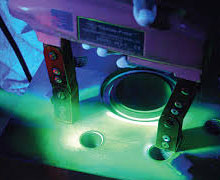Magnetic Particle Testing (MT)
 This NDT method is accomplished by inducing a magnetic field in a ferromagnetic material and then dusting the surface with iron particles (either dry or suspended in liquid). Surface and near-surface flaws produce magnetic poles or distort the magnetic field in such a way that the iron particles (inspection tool) are attracted to what is called as a leakage field and get concentrated at these locations. This produces a visible indication of defect on the surface of the material. The images above demonstrate a component before and after inspection using dry magnetic particles. This NDT method is accomplished by inducing a magnetic field in a ferromagnetic material and then dusting the surface with iron particles (either dry or suspended in liquid). Surface and near-surface flaws produce magnetic poles or distort the magnetic field in such a way that the iron particles (inspection tool) are attracted to what is called as a leakage field and get concentrated at these locations. This produces a visible indication of defect on the surface of the material. The images above demonstrate a component before and after inspection using dry magnetic particles.
COURSE OBJECTIVE:
This course aims at imparting an in-depth knowledge of applying MT to ferro-magnetic materials – welds, plates, castings and forgings The course concentrates on techniques, test parameters, types of magnetization and their merits and applications, nature of indications to judge the flaw’s severity (type and depth) more correctly, interpretation of indications, various standards, codes, specifications and procedures for MT prevalent in the industry etc.
COURSE CONTENT (Modified as per client’s job needs):
What constitutes a magnet, Theory of Magnetism, Magnetic domains, Magnetic Poles, Attraction / Repulsion, Un-magnetized and Magnetized materials, Types of magnetism : Ferro-magnetic / Paramagnetic / Diamagnetic, Magnetic Flux, Lines of flux, Flux Density, Magnetization, Barkhaussen effect, Permeability and Reluctance, Types of magnets, Horse shoe / bar / circular magnets, MT Principle, Magnetic particles, Leakage field, Its importance in MT, Behavior of materials under magnetic influence, Magnetizing forces, Magnetizing Currents : AC / DC / HWDC, Electricity and magnetism, Producing different types of magnetic fields : Circular / Longitudinal, Hysterisis Loop and what it means, Various magnetizing techniques, Distribution of magnetic flux in a material, Selection of a technique for a particular application, Head shot and coil methods, Prod and Yoke methods, Wet Continuous, Dry Continuous and Residual field method, Materials, sensitivity and indications, Current value requirements in inspection, Sensitivity and measurement of magnetization, Various units of magnetizing quantities, Relative merits of each technique, Demagnetization, Calibration Blocks and accessories, Safety
Practical’s
Introduction to MT techniques, their merits and criteria for selection, use of standard test blocks for calibration, Sensitivity setting, Detecting/ judging/sizing/locating flaws on specimens with known flaws; Reporting.
|